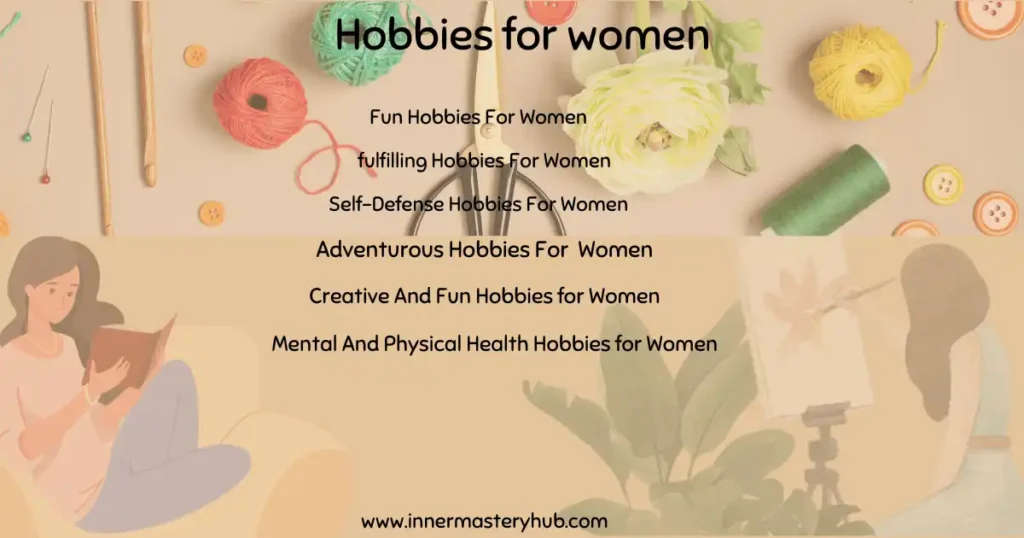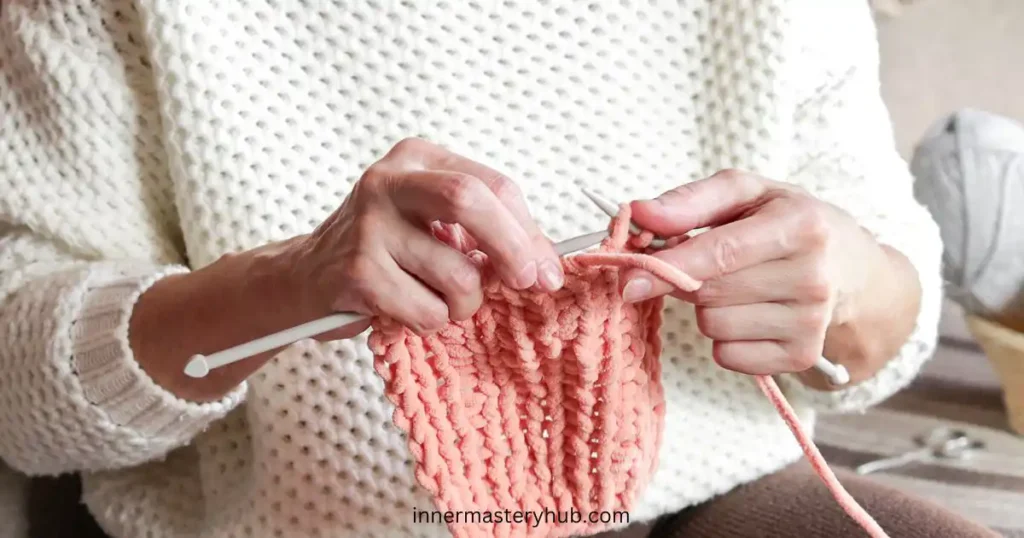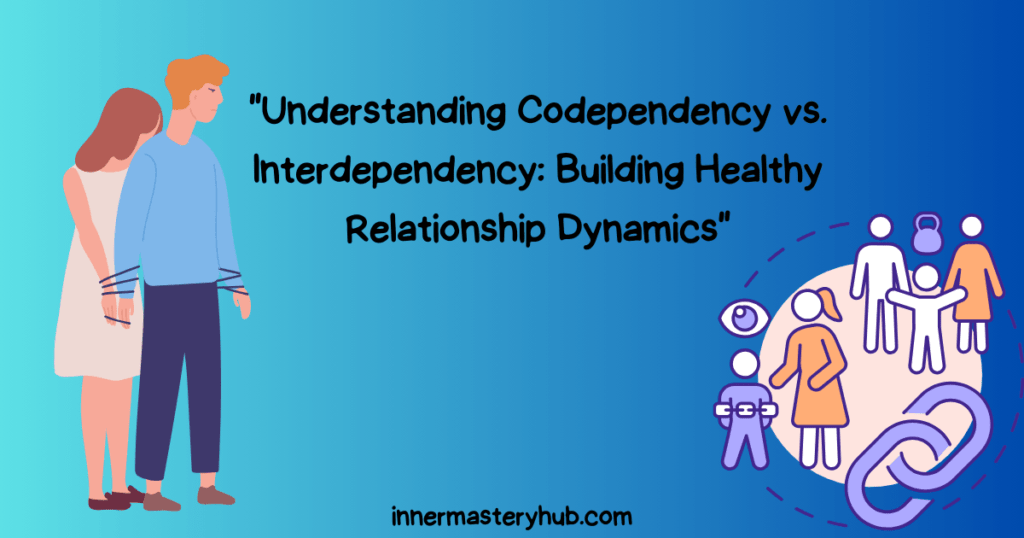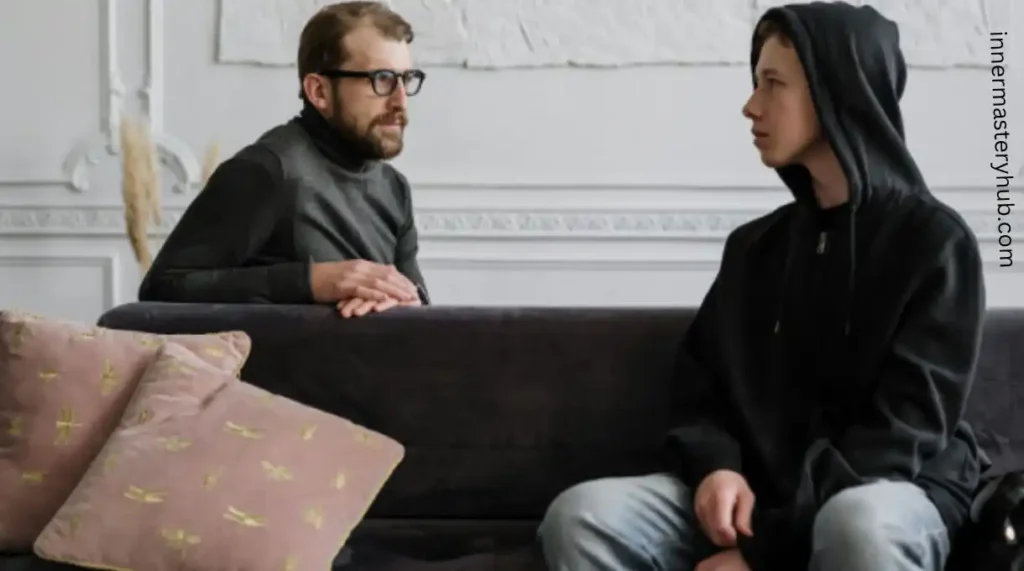60 Uplifting Hobbies for Women Who Feel Lost in Routine Life

Have you ever felt bored and unsure about how to spend your time? Is your routine boring you? Are you sick and tired of looking at your phone all day? It’s simple to get caught up in everyday activities and neglect to schedule self-care. Stress or a lack of personal fulfillment may result from this. The difficulty lies in discovering a hobby that not only complements your life but also brings you happiness and relaxation.
“The good news?” Women have a plethora of enjoyable and manageable activities to choose from. Suppose you’re looking for something artistic, calming, or active. In that case, there’s probably something that will work for you. By experimenting with various hobbies and discovering what truly interests you, you may find a way to enhance your life and bring joy into your daily routine.
Why is there a need for Hobbies for women
- Stress Relief. Provides a mental break and reduces stress.
- Increased Creativity. Stimulates imagination and creative thinking.
- Improved Mental Health. Boosts mood and serves as a creative outlet for anxiety and depression.
- Skill Development. Encourages learning new skills and improvement.
- Enhanced Social Connections. Helps build friendships and social networks.
- Increased Productivity. Offers structured breaks that boost overall productivity.
- Sense of Achievement. Provides a feeling of accomplishment and boosts confidence.
How To Find the Perfect Hobbies for Women
Discovering your ideal hobby is like finding a missing puzzle piece. It can be both exciting and overwhelming. Here’s how to find your perfect hobby:
- Consider your hobbies. What do you enjoy doing most when you have free time? Are you more attracted to academic difficulties, physical activities, or creativity?
- Go back to your childhood interests. Do you have any memories of the things you used to love? Perhaps you were interested in art, dancing, or collecting something.
- Examine new options. Go beyond your comfort zone and give something entirely new a shot. Maybe you’ll find a hidden talent!
- Think about the way you live. Consider how much money and time you can spend on a hobby. Select an option that works for your budget and schedule.
- Join a group or enroll in a class. Make relationships with like-minded individuals and gain knowledge from experts. This could be a great opportunity for women to explore new hobbies.
- Have fun and try new things. Never be scared to attempt new things. Around the corner, you might find the ideal activity.
Finding your passion takes time and effort. Be patient and enjoy the process of discovery.
Creative And Fun Hobbies for Women
You’re not alone if you desire something different because you feel like your routine is becoming a little monotonous. Finding rewarding and enjoyable hobbies can be a challenge for many women. When trying to fit something enjoyable into a hectic schedule and everything you try seems to fail, it can be frustrating.
But don’t worry; there are plenty of creative and fun hobbies for women that can break up monotony and bring excitement into your life. How about giving painting or drawing a try? It’s a great way to express yourself and unwind.
If you’re into hands-on activities, crafting, pottery, board games, or DIY projects, they could be perfect for you. They allow you to produce something you can be proud of in addition to being fulfilling. Additionally, if you’re seeking a social activity, taking a cooking class or joining a book club might be a terrific opportunity to indulge your interests and meet new people.
Finding the right hobby can transform your free time into something you look forward to and help add a refreshing change to your routine.
1. Card Games
You could find what you’re looking for in card games. They’re a terrific way to relax, have fun, and even push your mental limits. Card games may be an excellent way to unwind and interact with others, regardless of your preference for more casual games like Go Fish or UNO or more traditional ones like bridge or poker.
They are flexible and easy to incorporate into your schedule, as you can enjoy them alone or with friends. They can also be a fantastic technique to improve memory and strategic thinking.
Moreover, if you don’t have a deck of cards, these games are easily accessible online. Sudoku, crosswords, and jigsaw puzzles are excellent ways to keep the mind active. They provide a fulfilling challenge that you can complete alone or with others at your own pace. Additionally, these games are easily accessible online on sites.
2. Beekeeping
Beekeeping? It’s far cooler than you may imagine. Think about spending time with a group of tiny, active bees. Watching it is similar to having your miniature insect kingdom. You can also enjoy the honey they produce!
It’s naturally delicious and pleasurable. Additionally, you’re benefiting the environment because bees are essential for pollination, which supports the growth of flowers and other plants. Therefore, beekeeping can be your thing if you enjoy the outdoors and sweets.
3. Soapmaking.
Soapmaking is like baking, but for your skin! You get to play with colors, scents, and different oils. It’s totally fun and you can make soap for everyone – your mom, your best friend, even your dog!
The best part? You know exactly what’s going into your soap. No weird chemicals or anything. It’s all-natural, and you can make it as fancy or as simple as you want. Trust me, once you start, you won’t stop!
4. Painting Or Drawing
Both drawing and painting are fantastic forms of self-expression. Creating a lively and enjoyable appearance is the primary goal of painting. It’s similar to manipulating a rainbow on paper.
Drawing is not the same. It involves attempting to depict something’s true appearance through lines and shading. It’s like gaining a completely new perspective on the world. The best part, though? You are not required to choose only one! Why not try both and see what you like? Many artists do both.
5. Sculpting
Making sculptures is similar to working with 3D playdough. From nothing, you can mold and shape something. It’s a tactile pastime that allows you to feel the substance under your fingers.
Working with clay, wood, or even metal allows you to make something genuinely one-of-a-kind. The outcome makes up for the messiness. It’s quite satisfying to picture holding your work in your hands!
6. Sushi Making
For women, cooking sushi is a lot of fun! It resembles a fusion of art and cooking. It allows you to experiment with flavors and colors. Additionally, it’s a fantastic way to showcase your sophisticated skills to your friends. And who doesn’t enjoy consuming mouthwatering sushi prepared from scratch? It is quite satisfying!
7. Jewelry Making
The process of creating jewelry is similar to dressing up your accessories! To make something one-of-a-kind, you can choose your hues, gemstones, and forms. It’s similar to assembling a jigsaw puzzle, but much more intricate and detailed. Additionally, you can create jewelry for your loved ones. It’s a wonderful opportunity to indulge yourself and showcase your creative side.
8. Photography
The answer may lie in photography. It’s a pastime that lets you document and enjoy the world around you. Photography can offer a fresh perspective on things, whether you’re interested in capturing images of everyday life, cityscapes, or the natural world.
It’s a fantastic opportunity to use your creativity, and it can be as straightforward or complex as you choose. It’s also something you may do with friends and family or by yourself.
9. Creative Writing
The solution you seek may lie in creative writing. It provides an excellent means of communicating your ideas, feelings, and thoughts. Whether you want to write poetry, short stories, or even the first draft of a novel, creative writing lets you explore many facets of your life. You can modify this adaptable pastime to suit your hobbies and schedule, making it a wonderful way to decompress.
10. Candle Making
Create your own candles if you’re looking for a way to add a unique touch to your surroundings. You can experiment with various scents, hues, and forms to create lovely, fragrant candles that enhance any space. Making something useful and aesthetically pleasing is an enjoyable way to get your hands dirty.

11. Playing Video Games
It can be challenging for many women to unwind and relax through engaging activities. Whether you enjoy puzzle-solving, globe exploration, or action-packed adventures, video games provide a dynamic way to interact with entertainment. You can connect with friends and family to share the pleasure, and it’s a great way to relieve tension.
12. Interior Design Making
Through the selection of color palettes, furnishings, and décor, interior design enables you to take charge of your environment. It’s an imaginative method to update your house and give it a distinctly personal touch. You may express your individual taste and create a room that is both attractive and functional with interior design, regardless of your preference for vibrant colors or minimalist styles.
13. Knitting
Knitting is a classic pastime that fosters creativity and relaxation. Yarn can be transformed into fabric using needles to create a wide range of objects, including clothing and decorative items. Every project you work on gives you a sense of joy and success. With numerous yarn options and patterns to choose from, knitting fosters creativity while also enhancing concentration and patience. It’s satisfying to create something lovely while engaging in a soothing hobby.
14. Calligraphy Practicing
Perhaps calligraphy is what you’re looking for. Learn how to make lovely lettering in a variety of styles with specialist pens and brushes. This type of painting challenges your self-control and creative sense while offering a fulfilling means of crafting sophisticated handmade cards, invitations, and artwork. As you practice, you’ll also see improvements in your fine motor abilities.
15. Scrapbooking
Scrapbooking is a fantastic method to preserve and arrange your most treasured memories. Add stickers, background sheets, and embellishments like pressed flowers or ticket stubs to your best images. It’s an enjoyable and unique way to capture life’s special moments or create a sentimental gift, adding originality and nostalgia to your most treasured memories.
16. Gathering in Faith Communities
For many women, belonging to a faith group offers a supportive and purposeful setting. A network of supporting relationships, a sense of purpose, and spiritual growth can all be obtained by joining a church community.
It’s a chance to engage in group activities, make connections with people who share your values and ideas, and receive support and consolation when you need it. Your spiritual journey can be enhanced and enduring; meaningful relationships can be forged by joining a church community.
17. Meditation
You might benefit greatly from meditation. It presents an opportunity for mental relaxation, stress reduction, and overall improvement in well-being. You can enhance your self-awareness and emotional resilience by dedicating a few moments each day to meditation.
18. Journaling
Are you feeling overtaken by ideas or feelings? Maintaining attention and managing your emotions can be greatly aided by keeping a journal. It facilitates self-expression, helps you remember significant events, and enhances your understanding of various aspects of your life. It also provides a private space for you to think and organize your ideas.
19. Adult Coloring
Although the drawings are more complex and sophisticated, adult coloring offers a creative release similar to that of children. You can relax and lose yourself in intricate patterns with this peaceful activity, which provides a welcome diversion from the stresses of everyday life.
Mental And Physical Health Hobbies for Women
Here is a list of my favorite hobbies for women when it comes to nurturing mental and physical health:
20. YOGA
Yoga is a great way to stretch and strengthen your body while also calming your mind. The combination of movement and breath work helps reduce stress and increase flexibility, making it a well-rounded practice.
21. Walking or Hiking
Walking or hiking gets you moving while letting you enjoy the outdoors. It’s a simple way to improve your cardiovascular health and lift your mood, especially when you explore nature trails or scenic routes.
21. Walking or Hiking
You may enjoy the outdoors and get moving by going for a walk or taking a hike. When you explore scenic routes or nature paths, it’s an easy approach to boost your mood and cardiovascular health.
22. Gardening
You can get your hands dirty while doing something calming, such as gardening. It includes labor-intensive tasks like planting and excavating, but it also offers an opportunity to unwind and commune with nature.
23. Swimming
Swimming provides an easy-on-the-joints full-body workout. Being in the water can be really pleasant, and it’s a great way to increase strength and endurance.
24. Tai Chi
Tai chi combines deep breathing with calm, purposeful motions. Balance and flexibility are enhanced by this low-impact workout, which also helps to focus and relax the mind.
25. Cycling
Riding a bicycle is another method of traveling and staying in shape. Cycling gives you a sense of independence and strengthens your legs and heart, whether you’re riding a stationary bike or the road. Strength training exercises promote muscle growth and endurance. It’s a fantastic method to increase your physical strength, and as you see results over time, it can also boost your confidence.
Adventurous Hobbies For Women
If you’re craving some adventure in your life, here are a few hobbies for women that can get your heart racing and bring excitement into your routine.
26. Rock climbing
Rock climbing is a thrilling way to push your mental and physical limits. Reaching the top of indoor climbing walls or natural rock faces demands strength, planning, and concentration. Nothing compares to the rush of reaching the peak.
27. Surfing
The excitement of riding waves and establishing a connection with the water is what surfing gives. Your endurance, agility, and balance will be thoroughly tested in this sport. Since every wave is distinct, surfing is a unique and exciting experience every time.
28. Scuba diving
By exploring the undersea environment through scuba diving, you can find coral reefs and marine life. You can experience a sense of wonder and discovery through this calm yet thrilling hobby that leads you to locations that most people never see.
29. Skydiving
For those looking for an adrenaline rush, skydiving is the ultimate adventure. A completely new perspective on adventure is offered by the amazing experience of jumping out of an airplane and free-falling before your parachute opens.
30. Mountain biking
You venture onto rough paths and off the usual route when mountain biking. For individuals who love pushing their boundaries and discovering new places, this exhilarating sport blends speed, skill, and a passion for the outdoors.
31. Kayaking
While kayaking over rivers, lakes, or coastal waterways, you can experience both adventure and peace. Depending on where you decide to go, the trip might be either serene or an exhilarating ride through rapids.
32. Backpacking
By hiking with everything you need on your back, backpacking enables you to experience nature and visit far-flung locations. It’s an enjoyable opportunity to test your stamina and independence while taking in the splendor of the wilderness.
Self-Defense Hobbies For Women
If you’re interested in learning how to protect yourself while staying active, self-defense hobbies for women are also a great choice.
33. Krav Maga
Krav Maga is a realistic self-defense method that emphasizes real-world scenarios. It teaches you how to respond to various threats in a timely and effective manner by employing simple yet powerful tactics. The exercise increases both physical fitness and confidence.
34. Brazilian Jiu-Jitsu
The martial art of Brazilian Jiu-Jitsu has a strong emphasis on submission holds and ground combat. Women benefit greatly from it, as it teaches them how to use position and technique to outmaneuver larger opponents. It sharpens your talents and works your mind and body.
35. Aikido
Instead of using force to counter force, the Japanese martial art of aikido focuses on rerouting an attacker’s energy. For anyone who wishes to learn effective and non-aggressive self-defense techniques, it’s perfect. The methods prioritize harmony and balance.
36. Taekwondo
Fast punches and high kicks are hallmarks of the Korean martial art of Taekwondo. You can study self-defense and improve your strength, agility, and flexibility in a fun and engaging way. Taekwondo adopts a comprehensive approach to self-defense, emphasizing respect and discipline.
Punching, defending, and precise movement are all skills that boxing teaches. It’s a rigorous workout that develops both mental and physical resilience. Boxing not only helps you defend yourself but also enhances your coordination and response time.
Fun Hobbies For Women
37. Baking
A fun way to express your creativity in the kitchen is via baking. Whether you’re baking bread, cakes, or cookies, it’s fun to try different recipes and savor the delectable results. Additionally, there’s an added element of happiness when you share your delights with loved ones.
38. Crafting
Another enjoyable hobby that lets you create something original with your hands is crafting. Crafting offers you the opportunity to customize your creations and enjoy a soothing, practical activity, whether it’s knitting, scrapbooking, or DIY home décor.
39. Painting
You can express yourself through color and brushwork when you paint. Painting is a fun and soothing way to bring your creative ideas to life, whether you’re working on porcelain, canvas, or even furniture. The process, not just the final product, is what matters most.
40. Gardening
A fulfilling way to spend time outside while creating something lovely is to garden. Whether you’re cultivating herbs, vegetables, or flowers, gardening allows you to enjoy the results of your labor and establish a connection with the natural world.
41. Learning a musical instrument
Playing an instrument can be both enjoyable and challenging at the same time. Playing music may be a wonderful way to unwind and express your creativity, whether you decide to play the piano, guitar, or ukulele. Additionally, you can continue to improve it over time, which opens up numerous fun possibilities.
42. Exploring new cuisines
Using cooking as a means to experiment with different cuisines is a great way to add variety to your meals. You can transform an everyday meal into an exciting culinary experience in the comfort of your kitchen by experimenting with different flavors, methods, and ingredients.
43. Joining a book club
Reading and interacting with others are two benefits of joining a book club. Reading with others can open your eyes to different ideas and viewpoints, and it’s a terrific opportunity to meet new people while immersing yourself in intriguing tales.
Fulfilling Hobbies For Women
If you’re looking for hobbies for women that provide a sense of fulfillment and meaning, here are a few that can enrich your life and bring deep satisfaction.
44. volunteering
One method to give back to the community and improve the lives of others is by volunteering. Volunteering gives people a sense of purpose and connection, whether they are supporting a cause they care about, mentoring young people, or assisting at a local food bank.
45. Mentoring
Sharing your expertise and experiences with others is possible through teaching or mentoring. Giving advice to someone in your area, teaching a craft, or tutoring students are all fulfilling ways to watch others develop and thrive.
46. writing and blogging
Writing is a rewarding method to share your ideas, experiences, and tales. Journaling, blogging, or writing a novel are all forms of writing that offer a creative outlet and a means of leaving a legacy via your words.
47. learning a new skill
Your mind stays engaged and busy when you learn a new skill. Learning a new skill can be incredibly fulfilling and lead to new opportunities, whether it’s learning to code, playing a musical instrument, or acquiring a new language.
48. Exercise and Wellness Activities
Yoga, Pilates, and meditation are examples of practices that enhance both your physical and mental health, bringing you joy. Making a commitment to your health and witnessing improvements over time may be quite fulfilling.
49. photography
The beauty of nature, family gatherings, or everyday scenes can all be captured and preserved through photography. It’s a hobby that offers a fresh perspective on the world and helps you appreciate the little things.
50. traveling
Exploring new locations, cultures, and viewpoints is a rewarding aspect of travel. Travel expands your horizons, makes experiences that linger, and deepens your understanding of the world, whether it’s a weekend trip or a trip overseas.
10 interesting hobbies for an elderly woman
These suggestions can provide happiness, relaxation, and a sense of purpose if you’re looking for engaging leisure activities for ladies that are suitable for senior citizens.
Crocheting or knitting is a productive and soothing hobby for women. When creating warm products like hats, blankets, or scarves, it fosters creativity. It is ideal for maintaining engagement and providing considerate gifts because it is gentle on the joints and can be done at a slow pace.
A great way to spend time outdoors and take in the scenery is through gardening. Gardening offers a sense of achievement and the joy of caring for living things, whether you’re tending to a flower bed or cultivating herbs in pots.
A timeless hobby, reading can transport you to new places without requiring you to leave your chair. Novels, biographies, or even audiobooks are great ways to keep the mind sharp and engaged, especially if eyesight becomes an issue.
A quick and easy approach to being active is to go for a walk. Walking preserves mobility and offers an opportunity to take in the fresh air and natural surroundings, whether you’re strolling around the neighborhood or a local park.
Sudoku, crosswords, and jigsaw puzzles are excellent ways to keep the mind active. They provide a fulfilling challenge that you can complete alone or with others at your own pace.
Drawing or painting is a fantastic method to exercise your creativity. You may express yourself through colors and forms through these satisfying and calming exercises, even if you’ve never done them before.
Baking and cooking can be enjoyable, especially when experimenting with new recipes or recreating family favorites. Enjoying the process of making something delectable and maintaining a connection to traditions are two excellent benefits.
All you need is a cozy chair and a pair of binoculars to enjoy the soothing hobby of bird-watching. Seeing birds in your garden or a nearby park may be calming and enlightening, providing a sense of connection to the natural world.
There is a sense of camaraderie that comes with joining a social club or group. For mental and emotional health, maintaining social bonds is crucial, whether through senior center activities, book clubs, or knitting groups.
Podcasts and music listening can be both instructive and enjoyable. Listening to music and podcasts is a great way to unwind and keep your mind engaged, whether you’re revisiting old favorites or exploring new genres.
FAQS about hobbies for women
1. What are the best hobbies for women at home?
Cooking, baking, knitting, gardening, painting, and reading are among the most popular home hobbies for women. These activities reduce stress, encourage creativity, and are enjoyable both indoors and outdoors. Many also bring practical benefits, like homemade food or cozy crafts, while boosting confidence and providing a peaceful way to spend free time.
2. What are some creative hobbies for women?
Creative hobbies include painting, drawing, writing, jewelry-making, photography, calligraphy, and DIY crafts. These allow women to express emotions, explore imagination, and even build side businesses. Creativity-focused hobbies are relaxing, rewarding, and help improve problem-solving skills. They also offer opportunities to share unique handmade items with friends or online communities.
3. What hobbies for women can turn into a side income?
Blogging, baking, crafting, online tutoring, photography, handmade jewelry, and digital art are hobbies that women often monetize. Social media platforms make it easier to showcase talent, sell products, and connect with customers. With consistency, many women successfully turn their passion into a part-time or full-time income, enjoying both creativity and financial earnings.
4. What are relaxing hobbies for women?
Relaxing hobbies for women include yoga, meditation, journaling, coloring books, knitting, gardening, and aromatherapy. These activities calm the mind, improve mood, and reduce stress. Women enjoy them because they can be practiced at home with little investment. They also create balance, offering much-needed peace in today’s busy and stressful lifestyle.
5. What outdoor hobbies for women are great?
Hiking, cycling, swimming, jogging, birdwatching, and photography are great outdoor hobbies for women. These activities promote fitness, relaxation, and connection with nature. Outdoor hobbies for women also encourage adventure, fresh air, and social interactions. Many women enjoy them as both solo and group activities, which support physical health and mental well-being simultaneously.
6. What are inexpensive hobbies for women?
Affordable hobbies for women include reading, writing, walking, gardening, sketching, journaling, and learning free online courses. These require little or no investment and can be enjoyed daily. Women often choose them because they fit all lifestyles. Inexpensive hobbies also demonstrate that meaningful joy doesn’t always require money, but rather creativity and a willingness to invest time.
7. What hobbies improve mental health for women?
Mindful hobbies, such as yoga, meditation, journaling, painting, and music, are excellent ways to promote mental health. They reduce anxiety, encourage self-expression, and create positive routines. Hobbies for women specifically focus on relaxation and developing inner strength. Practicing such activities regularly helps build resilience and provides a healthy outlet for managing emotions, stress, and negative thoughts.
8. What hobbies for women help them stay fit?
Dancing, swimming, yoga, cycling, Pilates, aerobics, and martial arts are fitness-focused hobbies that women can enjoy. These activities strengthen the body, improve flexibility, and boost energy. They also enhance mood by releasing endorphins. Many women love fitness hobbies because they combine fun, health, and long-term benefits, making exercise feel enjoyable and social.
9. What hobbies are great for socializing for women?
Book clubs, dance classes, cooking groups, hiking clubs, art workshops, and volunteering are great ways to meet people. These hobbies help women make friends, share passions, and learn new skills. Social hobbies build confidence, create lasting relationships, and often encourage teamwork, making them both fun and meaningful for personal growth.
10. What are the trending hobbies for women today?
Current trends include yoga, blogging, vlogging, bullet journaling, photography, podcasting, DIY crafts, gardening, and learning new languages. Many women enjoy mixing traditional hobbies with digital platforms. These modern hobbies for women are creative, fun, and often shareable online. They also open doors to side incomes, global friendships, and continuous learning opportunities.






